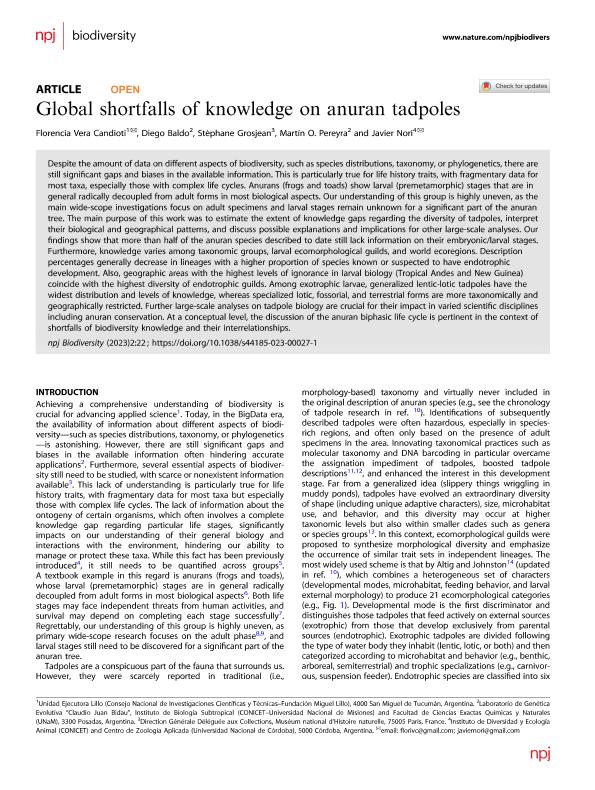Mostrar el registro sencillo del ítem
dc.contributor.author
Vera Candioti, María Florencia

dc.contributor.author
Baldo, Juan Diego

dc.contributor.author
Grosjean, S.
dc.contributor.author
Pereyra, Martín Oscar

dc.contributor.author
Nori, Javier

dc.date.available
2024-01-25T12:45:20Z
dc.date.issued
2023-10
dc.identifier.citation
Vera Candioti, María Florencia; Baldo, Juan Diego; Grosjean, S.; Pereyra, Martín Oscar; Nori, Javier; Global shortfalls of knowledge on anuran tadpoles; Nature; NPJ Biodiversity; 2; 1; 10-2023; 1-12
dc.identifier.issn
2731-4243
dc.identifier.uri
http://hdl.handle.net/11336/224768
dc.description.abstract
Despite the amount of data on different aspects of biodiversity, such as species distributions, taxonomy, or phylogenetics, there are still significant gaps and biases in the available information. This is particularly true for life history traits, with fragmentary data for most taxa, especially those with complex life cycles. Anurans (frogs and toads) show larval (premetamorphic) stages that are in general radically decoupled from adult forms in most biological aspects. Our understanding of this group is highly uneven, as the main wide-scope investigations focus on adult specimens and larval stages remain unknown for a significant part of the anuran tree. The main purpose of this work was to estimate the extent of knowledge gaps regarding the diversity of tadpoles, interpret their biological and geographical patterns, and discuss possible explanations and implications for other large-scale analyses. Our findings show that more than half of the anuran species described to date still lack information on their embryonic/larval stages. Furthermore, knowledge varies among taxonomic groups, larval ecomorphological guilds, and world ecoregions. Description percentages generally decrease in lineages with a higher proportion of species known or suspected to have endotrophic development. Also, geographic areas with the highest levels of ignorance in larval biology (Tropical Andes and New Guinea) coincide with the highest diversity of endotrophic guilds. Among exotrophic larvae, generalized lentic-lotic tadpoles have the widest distribution and levels of knowledge, whereas specialized lotic, fossorial, and terrestrial forms are more taxonomically and geographically restricted. Further large-scale analyses on tadpole biology are crucial for their impact in varied scientific disciplines including anuran conservation. At a conceptual level, the discussion of the anuran biphasic life cycle is pertinent in the context of shortfalls of biodiversity knowledge and their interrelationships.
dc.format
application/pdf
dc.language.iso
eng
dc.publisher
Nature

dc.rights
info:eu-repo/semantics/openAccess
dc.rights.uri
https://creativecommons.org/licenses/by/2.5/ar/
dc.subject
shortfalls
dc.subject.classification
Ecología

dc.subject.classification
Ciencias Biológicas

dc.subject.classification
CIENCIAS NATURALES Y EXACTAS

dc.subject.classification
Conservación de la Biodiversidad

dc.subject.classification
Ciencias Biológicas

dc.subject.classification
CIENCIAS NATURALES Y EXACTAS

dc.title
Global shortfalls of knowledge on anuran tadpoles
dc.type
info:eu-repo/semantics/article
dc.type
info:ar-repo/semantics/artículo
dc.type
info:eu-repo/semantics/publishedVersion
dc.date.updated
2024-01-22T12:46:25Z
dc.journal.volume
2
dc.journal.number
1
dc.journal.pagination
1-12
dc.journal.pais
Estados Unidos

dc.description.fil
Fil: Vera Candioti, María Florencia. Consejo Nacional de Investigaciones Científicas y Técnicas. Centro Científico Tecnológico - Tucumán. Unidad Ejecutora Lillo; Argentina
dc.description.fil
Fil: Baldo, Juan Diego. Consejo Nacional de Investigaciones Científicas y Técnicas. Centro Científico Tecnológico Conicet - Nordeste. Instituto de Biología Subtropical. Instituto de Biología Subtropical - Nodo Posadas | Universidad Nacional de Misiones. Instituto de Biología Subtropical. Instituto de Biología Subtropical - Nodo Posadas; Argentina
dc.description.fil
Fil: Grosjean, S.. Muséum National d'Histoire Naturelle; Francia
dc.description.fil
Fil: Pereyra, Martín Oscar. Consejo Nacional de Investigaciones Científicas y Técnicas. Centro Científico Tecnológico Conicet - Nordeste. Instituto de Biología Subtropical. Instituto de Biología Subtropical - Nodo Posadas | Universidad Nacional de Misiones. Instituto de Biología Subtropical. Instituto de Biología Subtropical - Nodo Posadas; Argentina
dc.description.fil
Fil: Nori, Javier. Consejo Nacional de Investigaciones Científicas y Técnicas. Centro Científico Tecnológico Conicet - Córdoba. Instituto de Diversidad y Ecología Animal. Universidad Nacional de Córdoba. Facultad de Ciencias Exactas Físicas y Naturales. Instituto de Diversidad y Ecología Animal; Argentina
dc.journal.title
NPJ Biodiversity
dc.relation.alternativeid
info:eu-repo/semantics/altIdentifier/url/https://www.nature.com/articles/s44185-023-00027-1
dc.relation.alternativeid
info:eu-repo/semantics/altIdentifier/doi/http://dx.doi.org/10.1038/s44185-023-00027-1
Archivos asociados
